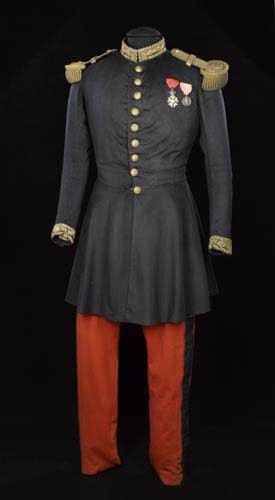When it came to his official portraiture, Napoleon III displayed a fondness for military uniforms. This preference, although entirely typical of a period during which uniforms were de rigueur at balls and on afternoon strolls, took on a particular significance for the Emperor. Once dressed in his uniform, the French sovereign – who, it should be noted, was not an officer in the French army – evinced a very specific imperial quality, the embodiment of an empire whose very name evoked victory and whose history was founded at least in part on the strategic genius of its famous architect.
In his portraits and paintings by Winterhalter, Flandrin, Couture, Gérôme, Hébert and numerous others, Napoleon III is depicted either in his ceremonial général de division uniform or in full military dress. Both were notable for the bicorn hat, the dark blue tailcoat with double-rank gold oakleaf embroidery, and the ceremonial belt. Depending on the preferred attire, the emperor would don either white breeches tucked in to his riding boots, or madder [a deep red dye] regimental pantaloons with a single dark blue stripe, worn over low-cut boots.
Yet in combat scenes, the emperor appears sporting a different outfit. Depictions of the battle of Solferino on 24 June 1859 painted by Yvon, Meissonier, Rigo and Charpentier all feature Napoleon III in a dark blue tunic and regimental pantaloons. This undress uniform was worn by divisional generals leading their troops. The uniform was completed by a sword belt and a bonnet de police à visière, a peaked cap (similar in form to a kepi), an example of which can be seen in Carrier-Belleuse’s magnificent bust portrait Napoléon III en Italie (musée d’Archéologie nationale, Saint-Germain-en-Laye).
The exhibition “Napoleon III and Italy” was the perfect opportunity for the Musée de l’Armée to introduce the public to the tunic and trousers worn by Napoleon III at the Battle of Solferino. The uniform – which corresponds exactly to the artists’ depictions – after which it has been incorporated into the museum’s permanent exhibitions, on permanent loan, to stand alongside the saddle used by the Emperor in combat.
As was the fashion at the time, the tunic is quilted across the chest. Pulled in at the skirt, the design emphasises the slimness of the waist and accentuates the militaristic air to the officer’s uniform. And yet whilst the finesse of the material and quality of the cut hint at the owner’s not insignificant means, there is nothing in the uniform to distinguish it from any other standard divisional general. When on the battlefield and surrounded by his peers, the commander in chief and head of state was a simple officer, an approach not entirely unlike that of his uncle.
Pinned to his breast are the star of the Légion d’honneur and the médaille d’Italie, created after the Franco-Austrian war of 1859, the latter of which serves as a reminder of the importance Napoleon III accorded to this campaign.
Emilie Robbe (tr. H.D.W.)
Musée de l’Armée
October 2011


